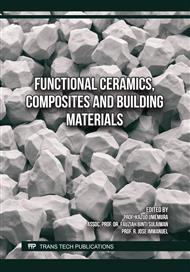p.29
p.41
p.49
p.55
p.61
p.71
p.77
p.87
p.99
Development of Light Weight Green Efficient Interlocking Blocks Using Waste Plastics and Industrial Wastes for Low Cost Housing Construction
Abstract:
Annually, billions of metric tonnes of solid waste are produced, including Polyethylene Terephthalate (PET) plastic waste and other industrial manufacturing by-products. This study assesses durability of waste plastic bricks (WPB), which are made by repurposing scrap plastics from PET. Mechanical and fire resistance properties of WPB have been optimised by varying mixing proportions of PET plastic and mixtures of industrial waste materials like fly ash, waste glass powder and concrete debris in ratios of (20:80, 30:70 and 40:60) respectively. This investigation integrates various wastes synergistically to produce bricks, aiming to replace traditional bricks made from cement and clay. This study investigates mechanical and physical properties of interlocking blocks made from mixtures of plastic and industrial waste materials, including fly ash, waste glass powder, and concrete debris. A mixture ratio of 20:80 (plastic to waste materials) yields a compressive strength of 27.3 N/mm², suitable for use in partition walls. Water absorption rates decrease significantly from 3.5% in conventional blocks to 0.5% in 20:80 ratio blocks, with further reductions to 0.43% and 0.40% for 30:70 and 40:60 ratios, respectively, enhancing water resistance. Efflorescence tests indicate improved performance in blocks with higher proportions of alternative materials, meeting highest standards for first-class bricks. Fire resistance tests confirm that all block compositions, including conventional and mixed ratio blocks, achieve a one-hour fire resistance duration, compliant with ASTM E119 standards, ensuring durability and safety of these alternative material blocks.
Info:
Periodical:
Pages:
71-76
Citation:
Online since:
March 2025
Authors:
Keywords:
Price:
Сopyright:
© 2025 Trans Tech Publications Ltd. All Rights Reserved
Share:
Citation:



